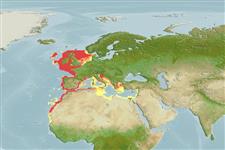Environment: milieu / climate zone / depth range / distribution range
Ecologia
marino demersale; distribuzione batimetrica 20 - 400 m (Ref. 35388). Subtropical; 60°N - 15°N, 18°W - 36°E
Northeast Atlantic: British Isles south to Senegal (baie du Lévrier) and the Mediterranean.
Length at first maturity / Size / Peso / Age
Maturity: Lm ?, range 14 - ? cm
Max length : 35.0 cm SL maschio/sesso non determinato; (Ref. 35388); common length : 14.0 cm TL maschio/sesso non determinato; (Ref. 3397); Età massima riportata: 14 anni (Ref. 32766)
Spine dorsali (totale) : 0; Raggi dorsali molli (totale) : 0. Upper eye less than its own diameter from dorsal profile of head. Anterior nostril on blind side not enlarged, its distance from front margin of head about twice in its distance from cleft of mouth. Anterior nostril on eyed side with backward-pointing tube reaching to front border of lower eye. Pectoral fin on eyed-side small, on blind side reduced.
Inhabits mud or sand bottoms. Feeds on a wide range of small bottom-living organisms, mainly crustaceans (amphipods, shrimps), also polychaete worms and bivalve mollusks (Ref. 4710). Utilized as a food fish.
Robins, C.R., R.M. Bailey, C.E. Bond, J.R. Brooker, E.A. Lachner, R.N. Lea and W.B. Scott, 1991. World fishes important to North Americans. Exclusive of species from the continental waters of the United States and Canada. Am. Fish. Soc. Spec. Publ. (21):243 p. (Ref. 4537)
IUCN Red List Status (Ref. 130435)
Threat to humans
Harmless
Human uses
Pesca: commerciale
Strumenti
Special reports
Download XML
Fonti Internet
Estimates based on models
Preferred temperature (Ref.
123201): 7 - 16, mean 10.3 °C (based on 434 cells).
Phylogenetic diversity index (Ref.
82804): PD
50 = 0.5078 [Uniqueness, from 0.5 = low to 2.0 = high].
Bayesian length-weight: a=0.00813 (0.00655 - 0.01008), b=3.05 (3.01 - 3.09), in cm total length, based on LWR estimates for this species (Ref.
93245).
Trophic level (Ref.
69278): 3.3 ±0.45 se; based on food items.
Resilienza (Ref.
120179): Medio, tempo minimo di raddoppiamento della popolazione 1.4 - 4.4 anni (K=0.37; tm=3; tmax=14).
Fishing Vulnerability (Ref.
59153): Moderate vulnerability (44 of 100).
Climate Vulnerability (Ref.
125649): Low vulnerability (9 of 100).
Nutrients (Ref.
124155): Calcium = 109 [39, 241] mg/100g; Iron = 1.02 [0.44, 2.16] mg/100g; Protein = 18.3 [16.5, 20.1] %; Omega3 = 0.199 [0.104, 0.365] g/100g; Selenium = 37.1 [18.3, 80.6] μg/100g; VitaminA = 8.2 [2.1, 30.8] μg/100g; Zinc = 0.664 [0.428, 0.992] mg/100g (wet weight); based on
nutrient studies.
